CONCEPT OF GOOD MANAGEMENT PRACTICES IN REPRODUCTION FOR PROFITABLE DAIRY BUSINESS
Compiled & Edited by-Dr. Deependra Singh Shekhawat
Former Assistant Research Scientist at Kaira District Co-operative Milk Producers' Union Ltd ( AMUL )
Good productions as well as good reproduction are two essential elements for making the dairy farming/business a profitable one. The ultimate goal of improving reproductive performance on a dairy is to improve profitability. In fact total milk production is determined by the proportion of cows along the different months of the lactation curve and by the level of milk production inside each of the different months. Improving reproductive efficiency improves profitability by maintaining the greatest proportion of cows in a herd producing milk at optimal levels.Here i am giving a brief Keynotes on Dairy animal Reproduction for the benefit of innovative dairy entrepreneurs.
Reproductive characteristics of cattle and buffaloes
Signs of oestrus in cattle and buffaloes
Best time for breeding of cattle and buffaloes
Importance of pregnancy diagnosis in cattle and buffaloes
Knowing the reproductive status of dairy animals
Reasons
Management
Reasons
Management
Reasons
Management
Infertility in cattle – causes and treatmentInfertility in cattle accounts for major economic losses in dairy farming and dairy industry in India. Maintaining an infertile animal is an economic burden and in most countries such animals are driven to slaughterhouses. In cattle, nearly 10-30 per cent of lactations may be affected by infertility and reproductive disorders. To attain good fertility or high calving rate both the male and female animals should be well fed and free from diseases. Reasons for infertility The causes of infertility are many and can be complex. Infertility or failure to conceive and give birth to a young one can be due to malnutrition, infections, congenital defects, management errors and ovulatory or hormonal imbalances in the female. Sexual cycle Both cows and buffaloes have the sexual cycle (oestrus) once in 18-21 days for 18-24 hours. But in buffaloes, the cycle is silent posing a big problem to the farmers. The farmers should closely monitor the animals 4-5 times from early morning to late night. Poor heat deduction can cause increased levels of infertility. Considerable skill is needed to deduct the animals in heat for visible signs. Farmers who maintain good records and spend more time watching the animals obtain better results. Tips to avoid infertility
|
|||||||||||||||||||||||||||||||||
| There are three techniques for pregnancy diagnosis:
· Clinical or direct method о Rectal palpation о Ultrasonography о Ballotment and mammogenesis i.e. development of mammary glands. · Immunological tests or indirect method о Hormone (progesterone, estron sulphate) о PAS (pregnancy associated substances): early pregnancy factor (EPF), pregnancy associated · Non return to estrus
Clinical or Direct Method Rectal Palpation Pregnancy Signs in Rectal Palpation: · Asymmetry of uterine horn · Position of uterus · Presence of fetal membrane – allento-chorion (upto 30-90 days these are detected), amniotic vesicle (as early as 35-40 days these are detected), placentomes (formed by fusion of crunkles and cotyledons. After 90 day detectable). · Presence of conceptus/fetus. · Presence of CL on ovary Estimation of stages of Pregnancy: 30 days: · Slight asymmetry of horn · Presence of CL · Chrio-allontoic membrane · Amniotic vesicle pea size · Uterus in pelvic cavity 35-40 days: · Uterus in pelvic cavity · Thinning of uterine wall · Presence of CL · Chrioallontoic membrane · Amniotic vesicle size is yolk of hen (0.7 cm). 45 day: · Uterus in pelvic cavity · Thinning of uterine wall · Presence of CL · Chorioallantoic membrane · Amniotic vesicle size small egg of hen 60 day: · Uterus in pelvic cavity · Presence of CL · Chorioallontoic membrane · Amniotic vesicle 9-10 cm · Fetus size 2.5 inch · Fetal membrane slip test is positives 90 day: · Uterine horn 3 inches in diameter · Placentome (1-1.5 cm) pea size · Presence of CL · Chorioallontoic membrane · Fetus 6.5 inch (rat size) 120 day: · Uterus descending in pelvic brim · Placentome (1.5-2.5 cm) · Presence of CL · Chorioallontoic membrane · Fetus 10-12 inch (small cat size) · Presence of Fremitus (uterine artery) 150 day: · Abdominal descending of uterus · Palpation is difficult because fetus is in abdominal cavity · Placentomes (2.5-4 cm) · Presence of CL · Fremitis (pulse feel in uterine artery) · Fetus is large cat sized 180 day: · Abdominal descending of uterus · Placentome (4-5 cm) equal to large coin · Presence of CL · Fremitus · Fetus is small dog sized 210 day: · Fetus easily felt due to increased size · Placentome · Fremitus
In this process real time B mode is used which detects the pregnancy at day 26. It is also used to detect fetus heart beat, size, twin pregnancy, fetal sex, and any abnormality etc.
Ballotment In later stages of pregnancy fetus may be palpable through right flank. Put pressure on the right side and feel fluid which is positive sign of pregnancy.
Mammogenesis Size of mammary glands increases. It is more pronounced in heifer after 4-5 months.
Immunological Tests or Indirect Method Hormone Analysis Progesterone:
Estronsulphate:
PAS (Pregnancy Associated Substances) Early Pregnancy Factor: Pregnancy Associated Glycoprotein:
|


